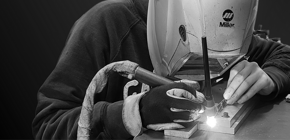In the world of aerospace manufacturing, innovation is the driving force behind creating safer, more efficient, and high-performance aircraft. One of the most transformative developments has been the integration of composite materials. With their lightweight, strong, and versatile properties, composites have revolutionized the aerospace industry. In this blog post, we take a closer look at the role composites play in shaping the future of aerospace manufacturing.
The Power of Composites:
Lightweight Excellence: Composites are celebrated for their remarkable strength-to-weight ratio, allowing aircraft to shed excess weight without compromising structural integrity. This weight reduction translates to improved fuel efficiency, extended range, and increased payload capacity.
Tailored Properties: The composition of composites can be customized by combining different materials, allowing engineers to precisely tailor properties such as stiffness, strength, and thermal resistance to meet specific requirements.
Corrosion Resistance: Unlike traditional metal alloys, composites are inherently corrosion-resistant, which is a significant advantage in aerospace applications exposed to harsh environmental conditions.
Design Flexibility: Composites offer the freedom to create intricate shapes and designs that optimize aerodynamics and overall aircraft performance, opening doors to innovative aircraft designs.
Applications in Aerospace Manufacturing:
Aircraft Structures: Composites are extensively used in primary and secondary aircraft structures, such as wings, fuselage sections, and tail components. These lightweight yet robust materials provide the necessary strength for flight while contributing to fuel efficiency.
Interior Components: Beyond external structures, composites are employed in interior components like cabin panels, overhead bins, and lavatory units. Their design flexibility enhances passenger comfort and contributes to the overall aesthetic appeal.
Aerospace Propulsion: Composites are utilized in engine components, including fan blades and shrouds. Their high-temperature resistance and durability contribute to efficient and reliable propulsion systems.
Spacecraft and Satellite Construction: In the realm of space exploration, composites are indispensable. They are used in spacecraft components and satellite structures due to their ability to withstand the vacuum of space, temperature extremes, and radiation exposure.
Innovations and Challenges:
Advanced Composite Manufacturing: Advancements in manufacturing techniques such as automated layup, resin infusion, and 3D printing have streamlined the production of complex composite structures, reducing costs and increasing efficiency.
Challenges and Considerations: While composites offer numerous advantages, challenges like repairability, long-term durability, and recycling need to be addressed. Research is ongoing to develop techniques for extending the lifespan of composite components and improving their environmental impact.
Composites have emerged as a driving force in aerospace manufacturing, reshaping the industry by providing lightweight strength, design flexibility, and exceptional performance. As research and development continue, composites are poised to further redefine the boundaries of aerospace engineering, enabling the creation of aircraft and spacecraft that are safer, more efficient, and capable of pushing the limits of exploration. The role of composites in the aerospace sector underscores their pivotal importance in shaping the future of flight.

COMMENTS